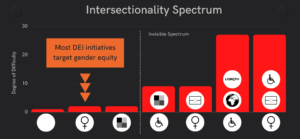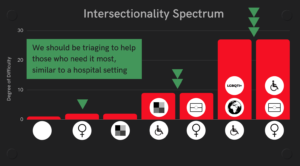I created a model to help visualise “degree of difficulty” based off the snakes and ladders picture below, so that it can be taken into account when looking at “merit”.
Please note the number of ladders for the person at the top of the image compared to the number of snakes at the bottom of the image.

But the risk is that this will dehumanise and this needs to be kept in mind as we continue. This is why we have to remember that “All models are wrong but some are useful” – George Box. Box, G. E. P. (1979), “Robustness in the strategy of scientific model building”, in Launer, R. L.; Wilkinson, G. N. (eds.), Robustness in Statistics, Academic Press, pp. 201–236, doi:10.1016/B978-0-12-438150-6.50018-2, ISBN 9781483263366.
The picture below is the Intersectionality Spectrum to help people become aware of how belonging to more than one marginalised group impacts your degree of difficulty. Please note that every Intersectionality Spectrum has to be contextual. That means that the model isn’t fixed, it is highly contextual and created to fit the situation you are focusing on.
Degree of Difficulty is calculated to tbe 2 to the power of the number of marginalised groups a person belongs to. Use base 3 for highly marginalised groups. So in the image below a white male that belongs to no marginalised groups would be 2 to the power of 0, or 1. A disabled First Nations woman would be 3 to the power of 3 which is 27.

Most DEI initiatives target gender equity. The graph below points to the second least degree of difficulty and highlights that most DEI initiatives target gender equity and actually help white women more than others.

This is why the image below shows 3 arrows pointing down on the bars that have the highest degree of difficulty to signify that we need to prioritise support to those who need it most because they have been discriinated the most. It has one green arrow pointing down to those with smaller degrees of difficulty to signify we still need to help those people as well, but with less intensity or frequency. This is similar to how a hospital should triage patients, in that we need to look after the sickest people first.
